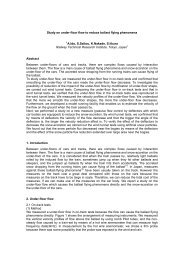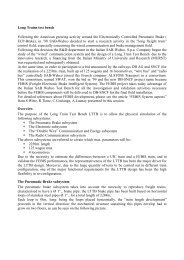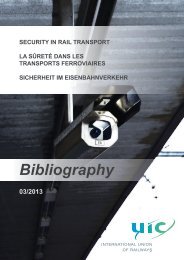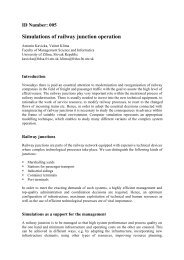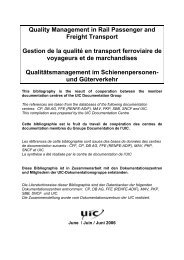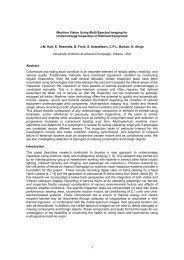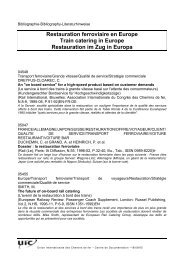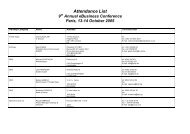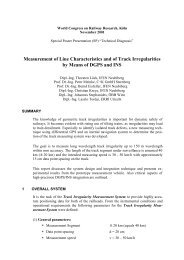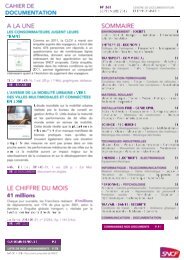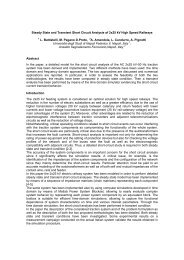Rail Interoperability in Spain. ERTMS real deployment 1I.J. Iglesias ...
Rail Interoperability in Spain. ERTMS real deployment 1I.J. Iglesias ...
Rail Interoperability in Spain. ERTMS real deployment 1I.J. Iglesias ...
You also want an ePaper? Increase the reach of your titles
YUMPU automatically turns print PDFs into web optimized ePapers that Google loves.
<strong>Rail</strong> <strong>Interoperability</strong> <strong>in</strong> Spa<strong>in</strong>. <strong>ERTMS</strong> <strong>real</strong> <strong>deployment</strong><br />
1 I.J. <strong>Iglesias</strong>. Present<strong>in</strong>g Author, 1 A. Berrios, 1 A. Arranz, 1 M. Cambronero1, 2 J.A.Jimenez,<br />
2 C.Arias, 2 I.Ribera, 3 D.Mol<strong>in</strong>a, 3 J.Tamarit and 3 J.Bueno Coauthors<br />
1 ADIF. <strong>Rail</strong>ways Infrastructure Manager, Madrid, Spa<strong>in</strong>. 2 Renfe Operadora. Spanish <strong>Rail</strong>ways<br />
operator, Madrid, Spa<strong>in</strong>. 3 CEDEX Studies and Experimentation Centre of Public Works and<br />
Transportation (Fomento) M<strong>in</strong>istry, Madrid, Spa<strong>in</strong><br />
Abstract<br />
This paper shows how, at the time be<strong>in</strong>g, the rail <strong>in</strong>teroperability is a <strong>real</strong>ity <strong>in</strong> Spa<strong>in</strong> by means of<br />
present<strong>in</strong>g the current implementation of <strong>ERTMS</strong>/ETCS (European <strong>Rail</strong> Traffic Management<br />
System/European Tra<strong>in</strong> Control System) <strong>in</strong> the new Spanish high speed l<strong>in</strong>es. This has been done <strong>in</strong><br />
the frame of the very ambitious Spanish high speed program which consists on the construction and<br />
putt<strong>in</strong>g <strong>in</strong> operation of approximately 9.000 Km of new HSLs <strong>in</strong> the period 2005-2020, with a total<br />
<strong>in</strong>vestment of around 83.000 M€. The role of Spa<strong>in</strong> as pioneer <strong>in</strong> implement<strong>in</strong>g the new signal<strong>in</strong>g<br />
system is clearly highlighted <strong>in</strong> this paper.<br />
1.- Introduction<br />
The ma<strong>in</strong> issue of this paper is to show how the <strong>real</strong> <strong>in</strong>teroperability among almost the totality of<br />
<strong>ERTMS</strong>/ETCS suppliers is be<strong>in</strong>g successfully tested <strong>in</strong> Spa<strong>in</strong>, present<strong>in</strong>g the behavior of l<strong>in</strong>es <strong>in</strong><br />
commercial operation as well as the new l<strong>in</strong>es to be open dur<strong>in</strong>g the next years.<br />
The success of ETCS <strong>real</strong> <strong>deployment</strong> is a clear demonstration that nowadays the rail <strong>in</strong>teroperability<br />
is a fact, and this paper highlight the role played by the Spanish railways as pioneers <strong>in</strong> the <strong>real</strong><br />
implementation of the system, solv<strong>in</strong>g the problems derived from the <strong>in</strong>tervention of many suppliers,<br />
as well as for the non stability of the ETCS specifications.<br />
The paper will clearly differentiate the role played by the ma<strong>in</strong> Spanish actors who have actively<br />
contributed to this <strong>deployment</strong>: 1) ADIF (Spanish railways <strong>in</strong>frastructure Manager) <strong>in</strong> his role of<br />
plann<strong>in</strong>g, construct<strong>in</strong>g, test<strong>in</strong>g and exploit<strong>in</strong>g the l<strong>in</strong>es. 2) Renfe Operadora (Spanish public rail<br />
operator) by the acquisition of new HS tra<strong>in</strong>s with many different ETCS equipments and 3) F<strong>in</strong>ally<br />
CEDEX <strong>Rail</strong> <strong>Interoperability</strong> lab, by means of test<strong>in</strong>g all the EVCs at lab and solv<strong>in</strong>g the ma<strong>in</strong><br />
<strong>in</strong>teroperability issues appeared dur<strong>in</strong>g the tests. This paper would like to po<strong>in</strong>t out the role played by<br />
the <strong>Rail</strong>ways General Directorate of the Spanish M<strong>in</strong>istry of Public Works and Transportation, as the<br />
System Authority of the l<strong>in</strong>es implement<strong>in</strong>g <strong>in</strong>teroperable systems.<br />
2.- The Spanish Infrastructure and Transport Strategic Plan 2005-2020 (PEIT)<br />
The Spanish High Speed Program is very ambitious and it is based on the Spanish Infrastructure and<br />
Transport Strategic Plan 2005-2020 (PEIT) that foreseen the construction of almost 10.000 km of new<br />
HS l<strong>in</strong>es with a total <strong>in</strong>vestment of 108.766 M€ for railways <strong>in</strong> this period. This high <strong>in</strong>vestment is<br />
divided <strong>in</strong> four chapters: 1) High Speed L<strong>in</strong>es 83.450 M€, 2) Ma<strong>in</strong>tenance and improv<strong>in</strong>g of<br />
conventional network 18.000M€, 3) Levels cross<strong>in</strong>g suppression 3.560 M€ and 4) New roll<strong>in</strong>g stock<br />
3.750 M€. Figure 1 shows the new high speed l<strong>in</strong>es foreseen at PEIT. In this plan the new l<strong>in</strong>es won’t<br />
be exclusively for passenger’s traffic but also for mixed freight-passengers traffic. Furthermore some<br />
of the old l<strong>in</strong>es could be also dedicated to freight traffic, with the target of <strong>in</strong>creas<strong>in</strong>g the rate of freight<br />
transportation by railways, which at present time is very low <strong>in</strong> Spa<strong>in</strong> (around 3%).<br />
The previous mentioned <strong>in</strong>vestment for railways represents a percentage of 44% of the total<br />
<strong>in</strong>vestment foreseen <strong>in</strong> Spa<strong>in</strong> for Infrastructures and transport modernization <strong>in</strong> the period 2005-2020.<br />
Based on it, Spanish railways have clearly bet for implement<strong>in</strong>g <strong>ERTMS</strong>/ETCS <strong>in</strong> this network. The<br />
first steps of this important challenge are detailed <strong>in</strong> this paper.
Figure 1: New High Speed l<strong>in</strong>es foreseen at PEIT(Spanish Infrastructure and Transport<br />
Strategic Plan 2005-2020). This plan <strong>in</strong>cludes both passengers and mixed traffic HSL.<br />
3.- <strong>Interoperability</strong> <strong>in</strong> Spa<strong>in</strong>. <strong>ERTMS</strong><br />
HIGH PERFORMANCES RAIL NETWORK<br />
HORIZON 2020<br />
Exclusively passengers<br />
Autonomic Communities<br />
Mixed network:Freight and passengers<br />
CURRENT CONVENTIONAl NETWORK<br />
In the frame of this ambitious High Speed Program, Spa<strong>in</strong> decided <strong>in</strong> 2000 to <strong>in</strong>stall <strong>ERTMS</strong> <strong>in</strong> all the<br />
new l<strong>in</strong>es with the target of promot<strong>in</strong>g the open market among all the signal<strong>in</strong>g systems suppliers.<br />
This high risk decision was adopted as the only possible solution to <strong>real</strong>ly migrate <strong>in</strong> the future to a<br />
<strong>real</strong> open rail market follow<strong>in</strong>g the future railways model: rail network will be constructed and<br />
adm<strong>in</strong>istrated by a public <strong>in</strong>stitution and rail operation will be done by both public and private<br />
companies. The <strong>in</strong>stallation of an unique, <strong>in</strong>teroperable and public system as ETCS is the only way to<br />
open the access of new rail operators by avoid<strong>in</strong>g the restriction caused by the <strong>in</strong>stallation of a private<br />
proprietary signal<strong>in</strong>g system.<br />
Although the most impressive part of Spanish program are the new high speed l<strong>in</strong>es, also the<br />
conventional l<strong>in</strong>es will be renewed and <strong>in</strong> all of them the new ETCS system will be progressively<br />
<strong>in</strong>stalled replac<strong>in</strong>g the old ASFA Spanish signal<strong>in</strong>g system. Obviously this process will be very long,<br />
and although <strong>in</strong> some cases as Madrid and Barcelona commuter l<strong>in</strong>es this replacement is go<strong>in</strong>g to be<br />
done <strong>in</strong> the near future, the whole network replacement will take a long time.<br />
Another important pend<strong>in</strong>g issue <strong>in</strong> Spa<strong>in</strong> is the Iberian gauge (1665 mm) which is wider than the<br />
standard UIC gauge (1435 mm). All the new high speed l<strong>in</strong>es are UIC gauge (<strong>in</strong>clud<strong>in</strong>g the first one<br />
Madrid-Seville <strong>in</strong> operation from 1992), but the rest of the network l<strong>in</strong>es (<strong>in</strong>clud<strong>in</strong>g Portuguese<br />
network) are Iberian gauge, mak<strong>in</strong>g more complex the achievement of a <strong>real</strong> <strong>in</strong>teroperability <strong>in</strong>side<br />
the Iberian pen<strong>in</strong>sula. By this reason Spa<strong>in</strong> is one of the countries more advanced <strong>in</strong> the variable<br />
gauges tra<strong>in</strong>s, as well as <strong>in</strong> the <strong>in</strong>stallations that modify the tra<strong>in</strong> gauge. At least ten of these facilities<br />
are now <strong>in</strong> operation, allow<strong>in</strong>g tra<strong>in</strong> transfers between both networks, and therefore facilitat<strong>in</strong>g the
<strong>in</strong>teroperability <strong>in</strong>side Spa<strong>in</strong>. Tra<strong>in</strong>s CAF (S-120) and Talgo (S-130) are variable gauge tra<strong>in</strong>sets,<br />
currently <strong>in</strong> operation at speeds up to 250 km/h.<br />
For all the previous reasons Spa<strong>in</strong> is one of the countries which have clearly bet on the ETCS/<strong>ERTMS</strong><br />
as the only way of achiev<strong>in</strong>g <strong>real</strong> <strong>in</strong>teroperability. The decision of <strong>in</strong>stall<strong>in</strong>g this signal<strong>in</strong>g system <strong>in</strong><br />
Spa<strong>in</strong> is not only justified by the technical <strong>in</strong>teroperability but also by the competitivity allowed by the<br />
<strong>in</strong>stallation of this system: <strong>ERTMS</strong>/ETCS is the only signal<strong>in</strong>g system which allow the open<br />
competition among different suppliers, and therefore is the best solution to start the development of a<br />
so ambitious high speed network as the Spanish one.<br />
Spa<strong>in</strong>, as it is clearly shown <strong>in</strong> this paper, has been the pioneer on <strong>in</strong>stall<strong>in</strong>g both <strong>ERTMS</strong> levels 1<br />
and 2 with different suppliers for track and tra<strong>in</strong> equipments. This way, started <strong>in</strong> 2000, has been<br />
plenty of obstacles: ETCS specifications migration from 2.0.0 to 2.2.2, different <strong>in</strong>terpretation by<br />
different suppliers, a lot of change request cont<strong>in</strong>uously add<strong>in</strong>g possible modifications, a lot of<br />
discussions to achieve agreements among competitors, new version 2.3.0.etc, etc… However,<br />
although the way has been hard, at the time be<strong>in</strong>g it can be said that <strong>in</strong>teroperability for level 1 is a<br />
fact (tra<strong>in</strong>s <strong>in</strong> commercial operation are circulat<strong>in</strong>g with ETCS from May 2006 with a high rate of<br />
reliability and punctuality) and for level 2 it will be a <strong>real</strong>ity <strong>in</strong> the first semester of 2008.<br />
4.- <strong>ERTMS</strong> High Speed L<strong>in</strong>es <strong>in</strong> Spa<strong>in</strong>: current and future situation<br />
ADIF as the Spanish <strong>Rail</strong>ways Adm<strong>in</strong>istrator has the task of both build<strong>in</strong>g and manag<strong>in</strong>g not only the<br />
HSL but the totality of the national l<strong>in</strong>es. Therefore ADIF has the mandate of the Spanish Government<br />
to build and put <strong>in</strong> operation the new l<strong>in</strong>es foreseen by PEIT and shown <strong>in</strong> figure 1. Figure 2 shows<br />
the ADIF prediction up to 2015. Some of this l<strong>in</strong>es are currently <strong>in</strong> commercial operation, some of then<br />
are <strong>in</strong> a very advanced status of construction, and the rest have been already started build<strong>in</strong>g.<br />
SPANISH HIGH SPEED LINES<br />
Commercial operation<br />
End 2007<br />
End 2008<br />
End 2009<br />
End 2010<br />
Sistema Foreseen LZB 2010-2015<br />
Dotted t<strong>in</strong>e LZB System<br />
Cont<strong>in</strong>uous l<strong>in</strong>e <strong>ERTMS</strong> System<br />
Figure 2: ADIF High Speed L<strong>in</strong>es <strong>in</strong> commercial operation and l<strong>in</strong>es foreseen up to 2015.<br />
However as this paper is ma<strong>in</strong>ly focused <strong>in</strong> the ETCS <strong>Interoperability</strong> the attention will be focused <strong>in</strong><br />
the l<strong>in</strong>es already <strong>in</strong> commercial operation, or <strong>in</strong> the l<strong>in</strong>es under ETCS tests, where the problems<br />
arisen form the participation of many suppliers can be clearly shown. The follow<strong>in</strong>g table (Table I)<br />
summarizes the current (January 2008) status of those l<strong>in</strong>es:
L<strong>in</strong>e ETCS<br />
Supplier<br />
Madrid-<br />
Lleida<br />
Ansaldo<br />
(CSEE)<br />
ETCS Level/<br />
Speed<br />
Length Current situation Future issues Tra<strong>in</strong>s<br />
operat<strong>in</strong>g <strong>in</strong><br />
this l<strong>in</strong>e<br />
Track equipment. High Speed L<strong>in</strong>es .UIC Gauge<br />
1/300Km/h<br />
2/350 Km/h<br />
Lleida-Roda Thales 1/300Km/h<br />
2/350 Km/h<br />
Roda-<br />
Barcelona<br />
Zaragoza-<br />
Huesca<br />
Madrid-<br />
Valladolid<br />
Córdoba-<br />
Málaga<br />
Albacete-La<br />
Enc<strong>in</strong>a<br />
Madrid<br />
Commuter<br />
l<strong>in</strong>es<br />
Thales 1/300Km/h<br />
2/350 Km/h<br />
480 Km Commercial<br />
Operation L1 May<br />
2006<br />
92 Km Commercial<br />
Operation L1 Dec<br />
2006<br />
L2 <strong>in</strong> operation at first<br />
semester 2008<br />
L2 <strong>in</strong> operation at the<br />
end of 2008<br />
80 Km Under f<strong>in</strong>al Tests Commercial<br />
operation: March<br />
2008<br />
Alstom 1/200 Km/h 80 Km Commercial operation<br />
with ASFA<br />
Thales 1/300Km/h<br />
2/350 Km/h<br />
Invensys 1/300Km/h<br />
2/350 Km/h<br />
Bombardier 1-2<br />
220 Km/h<br />
Thales<br />
/Dimetronic<br />
180 Km Commercial<br />
Operation L1<br />
December 2007<br />
155 Km Commercial<br />
Operation LSTM<br />
(LZB) December 2007<br />
(also L1 equipped)<br />
Conventional l<strong>in</strong>es. Spanish Gauge<br />
<strong>ERTMS</strong> L1 operation.<br />
Mid 2008<br />
L2 <strong>in</strong> Operation at the<br />
end 2008.<br />
L2 <strong>in</strong> Operation at the<br />
end 2008.<br />
90 Km Under tests Commercial<br />
operation : End 2008<br />
L1 and L2 160 Km Under development Commercial<br />
Operation Mid 2009<br />
Total length: 1317 Km. High speed l<strong>in</strong>es: 1067. Conventional (Spanish gauge) l<strong>in</strong>es: 250 Km.<br />
S-102, S-103<br />
and S-120<br />
S-102, S-103<br />
and S-120<br />
S-102, S-103.<br />
S-102 and S-<br />
104<br />
S-102 and S-<br />
130<br />
S-100, S-102<br />
and S-103<br />
Table I. L<strong>in</strong>es equipped with ETCS, already <strong>in</strong> operation or under test or development.<br />
As it is shown <strong>in</strong> the previous table all the current ETCS suppliers have taken part <strong>in</strong> these Spanish<br />
l<strong>in</strong>es (Thales and Dimetronic l<strong>in</strong>es are equipped with Siemens eurobalises), and therefore all the<br />
aspects related to <strong>in</strong>teroperability have been ma<strong>in</strong>ly tested there. Ma<strong>in</strong> problems detected dur<strong>in</strong>g the<br />
tests and <strong>real</strong> implementation are described <strong>in</strong> this paper.<br />
Figure 3 Madrid-Tarragona (Roda) High Speed l<strong>in</strong>e<br />
Alaris<br />
Civia.
5.- High Speed tra<strong>in</strong>s equipped with ETCS<br />
To complement the role performed by ADIF, Renfe Operadora, the public Spanish rail operator, have<br />
started test<strong>in</strong>g a big number of HS tra<strong>in</strong>s, equipped with different ETCS suppliers. Table II<br />
summarizes this <strong>in</strong>formation:<br />
Tra<strong>in</strong> 100 102 103 104<br />
Class Serie 100 Serie 102 Serie 103 Serie 104 Serie 120 Serie 130<br />
Tra<strong>in</strong> supplier Alstom Talgo - Bombardier Siemens Alstom - CAF CAF - Alstom Talgo - Bombardier<br />
Fleet 18 + 6<br />
Composition<br />
2 power heads<br />
8 cars<br />
*Speed <strong>in</strong> conventional l<strong>in</strong>es (Iberian gauge). Tra<strong>in</strong>s S-120 and S-130 have variable gauge systems.<br />
16<br />
30<br />
2 power heads<br />
12 cars<br />
26<br />
Table II. Renfe High Speed tra<strong>in</strong>s equipped with ETCS <strong>in</strong> commercial operation.<br />
Additionally to this table Renfe is <strong>in</strong>stall<strong>in</strong>g Invensys-Dimetronic ETCS equipment <strong>in</strong> 10 Alaris tra<strong>in</strong>s<br />
(series 490) which will circulate <strong>in</strong> the track Albacete-La Enc<strong>in</strong>a (spanish gauge).<br />
At the time be<strong>in</strong>g the six tra<strong>in</strong>s described <strong>in</strong> the previous table are <strong>in</strong> commercial operation <strong>in</strong> the l<strong>in</strong>es<br />
as it is also described <strong>in</strong> table I. Table II summarizes the results, related to reliability, punctuallity<br />
obta<strong>in</strong>ed with the tra<strong>in</strong>s more time operat<strong>in</strong>g (Siemens S-103 and Talgo S-102) The comb<strong>in</strong>ation of<br />
these tra<strong>in</strong>s with the ADIF’s l<strong>in</strong>es show the complexity of the Spanish HS program from the po<strong>in</strong>t of<br />
view of <strong>Interoperability</strong>. This clearly shows the role played by Spa<strong>in</strong> as a “Real <strong>Interoperability</strong> Lab” ,<br />
as well as the resolution of all the problems appeared dur<strong>in</strong>g the sett<strong>in</strong>g up process has allowed the<br />
fact of start operat<strong>in</strong>g commercial l<strong>in</strong>es with ETCS. Figures 4 and 5 show the cab of S-102 and S-103<br />
respectively, both equipped with <strong>ERTMS</strong>/ETCS.<br />
Figure 4. Talgo S-102 tra<strong>in</strong> cab<strong>in</strong> equipped with ETCS<br />
20<br />
13<br />
12<br />
16 **<br />
8 cars 4 cars 4 cars<br />
45<br />
2 power heads<br />
11 cars<br />
Length (m) 200,15 200,24 200,32 107,1 107,3 185,2<br />
Speed (km/h) 300 330 350 250 250 ( 220 ) * 250 ( 220 ) *<br />
Seats 328 (+1 hp)<br />
314 (+2 hp)<br />
346 (+2 hp)<br />
402 (+2 hp)<br />
236 (+1 hp)<br />
229 (+1 hp)<br />
237 (+1 hp) 298 (+1 hp)<br />
Type of power Synchronous Asynchronous Asynchronous Asynchronous Asynchronous Asynchronous<br />
Signall<strong>in</strong>g<br />
<strong>ERTMS</strong>-LZB-<br />
ASFA<br />
<strong>ERTMS</strong>-STM LZB-<br />
ASFA<br />
<strong>ERTMS</strong>-STM LZB-<br />
ASFA<br />
<strong>ERTMS</strong> - LZB -<br />
ASFA<br />
<strong>ERTMS</strong> supplier Alstom Siemens Siemens Alstom<br />
<strong>ERTMS</strong> - ASFA<br />
Ansaldo-CSEE<br />
Transport<br />
<strong>ERTMS</strong>-STM LZB-<br />
EBICAB-ASFA<br />
Bombardier<br />
Commercial service 1992 2005 2007 2004 2006 2007
Figure 5. Siemens S-103 tra<strong>in</strong> cab<strong>in</strong> equipped with ETCS<br />
F<strong>in</strong>ally table III summarizes the results, related to <strong>in</strong>cidences for both ETCS and STM-LZB obta<strong>in</strong>ed<br />
with the tra<strong>in</strong>s which started before the commercial operation (Siemens S-103 and Talgo S-102)<br />
Talgo-S-102 Siemens S-103<br />
ETCS STM LZB ETCS STM LZB<br />
Commercial Operation May- 2006 Nov-2007 June 2007 June 2007<br />
Total circulations 9,219 80 1,592 471<br />
Total Kms 3,670,126 118,855 840,576 223,494<br />
N er of Incedences 31* 17 3 10<br />
KM/ Incidences 118,391.16 6,991.47 280,192.00 22,349.40<br />
*16 of the 31 <strong>in</strong>cidences were due to odometry problems (with ice and snow) already solved.<br />
6.- <strong>Interoperability</strong> cross table<br />
Table III. ETCS and STM-LZB first exploitation data..<br />
As a summary of the two previous paragraphs, table IV describes the <strong>real</strong> state of <strong>in</strong>teroperability <strong>in</strong><br />
Spa<strong>in</strong> by means of show<strong>in</strong>g <strong>in</strong> a cross analysis both the current and future implementations of ETCS<br />
<strong>in</strong> track and on board <strong>in</strong>stallations:<br />
ON BOARD<br />
EQUIPMENT<br />
CROSS<br />
INTEROPERABILITY<br />
IN SPAIN<br />
TRACK EQUIPMENT<br />
Alstom Ansaldo Bombardier Invensys<br />
(Siemens balise)<br />
Thales<br />
(Siemens balise)<br />
AlstomS-104 YES YES YES<br />
Ansaldo S-120 YES YES YES<br />
Bombardier S-130 Under tests Under tests<br />
InvensysAlaris tra<strong>in</strong>s YES<br />
SiemensS-102/S-103 YES YES YES YES<br />
Thales No on board unit from Thales<br />
Table IV. Cross <strong>Interoperability</strong> <strong>in</strong> Spa<strong>in</strong>. ETCS l<strong>in</strong>es versus ETCS tra<strong>in</strong>s.
7.- Field Tests<br />
Before start<strong>in</strong>g the l<strong>in</strong>es commercial exploitation with different tra<strong>in</strong>s, it was necessary to perform<br />
some tests to assure the same <strong>in</strong>terpretation of the specifications, as well as to demonstrate<br />
<strong>in</strong>teroperability among all the exist<strong>in</strong>g suppliers.<br />
The first phase of this process was performed at CEDEX <strong>Rail</strong> <strong>Interoperability</strong> Lab <strong>in</strong> 2004 and 2005,<br />
where all the exist<strong>in</strong>g EVCs (European Vital Computer) from Ansaldo, Siemens, Alstom, Invensys and<br />
Bombardier were tested <strong>in</strong> a laboratory simulated track and also <strong>in</strong> a laboratory track reproduc<strong>in</strong>g<br />
Madrid-Lleida l<strong>in</strong>e. These tests are better expla<strong>in</strong>ed <strong>in</strong> paragraph 8, but it is necessary to po<strong>in</strong>t out the<br />
importance of hav<strong>in</strong>g performed these lab tests before start test<strong>in</strong>g equipments on <strong>real</strong> track.<br />
Obviously, all the ETCS equipments on board or on track are previously tested by the suppliers. EVCs<br />
are tested <strong>in</strong> supplier’s lab and track <strong>in</strong>stallation is tested by means of perform<strong>in</strong>g validation tests<br />
done by the supplier with an EVC selected by him. However, before putt<strong>in</strong>g <strong>in</strong> operation any l<strong>in</strong>e <strong>in</strong><br />
Spa<strong>in</strong>, it was decided (ma<strong>in</strong>ly based on the results obta<strong>in</strong>ed at CEDEX lab) that some additional tests<br />
were necessary to demonstrate the correct <strong>in</strong>tegration of the whole system composed by the on<br />
board equipment and the track <strong>in</strong>stallation. These system <strong>in</strong>tegration tests have been called<br />
“Complementary Tests” and have been def<strong>in</strong>ed jo<strong>in</strong>tly by ADIF, RENFE, CEDEX and TIFSA under the<br />
coord<strong>in</strong>ation of the M<strong>in</strong>istry of Fomento (Public Works and Transportation).<br />
This group has created the “ETCS Complementary Validation Tests” by means of first creat<strong>in</strong>g a set<br />
of Test Cases based on the functionality implemented <strong>in</strong> the two first Spanish l<strong>in</strong>es (Madrid-Lleida and<br />
Lleida-Tarragona). The aim of these Test cases is to check the <strong>in</strong>tegration of an On Board Unit <strong>in</strong> a<br />
Spanish l<strong>in</strong>e. These tests are not exhaustive nor <strong>in</strong>tend to demonstrate the safety of the system,<br />
because these two issues shall be demonstrated by the suppliers with the correspond<strong>in</strong>g certification<br />
and safety case processes.<br />
The work<strong>in</strong>g group has created a total number of 215 Test Cases when a new On Board Unit is go<strong>in</strong>g<br />
to be tested either <strong>in</strong> a new l<strong>in</strong>e or <strong>in</strong> an already validated l<strong>in</strong>e. These test cases summarize the most<br />
important functionality of the Spanish l<strong>in</strong>es with the aim of demonstrat<strong>in</strong>g the correct <strong>in</strong>tegration<br />
between on board and track ETCS subsystems. The Test cases have to be translated <strong>in</strong>to scenarios<br />
<strong>in</strong> each specific l<strong>in</strong>e, tack<strong>in</strong>g <strong>in</strong>to account the specific rout<strong>in</strong>g and functionality implemented <strong>in</strong> each<br />
l<strong>in</strong>e. Obviously, the translation <strong>in</strong>to scenarios would try to m<strong>in</strong>imize the number of runs to be<br />
performed on the l<strong>in</strong>e. Typical time to perform the whole set of test Cases for a new EVC takes<br />
around 3 weeks, depend<strong>in</strong>g on the specific functionality of each l<strong>in</strong>e.<br />
As the process of test<strong>in</strong>g <strong>in</strong> the <strong>real</strong> l<strong>in</strong>e is expensive and it takes a long time, it was decided to<br />
reduce the number of Test Cases when a new l<strong>in</strong>e is go<strong>in</strong>g to be tested with an already validated On<br />
Board unit. In this case the number of Test Cases has been reduced to 69 and the total time can vary<br />
between 4 and 6 labour days.<br />
The third situation is the case that an On Board Unit (OBU) which was validated <strong>in</strong> another ETCS l<strong>in</strong>e<br />
is go<strong>in</strong>g to operate <strong>in</strong> a new l<strong>in</strong>e (already validated with a different OBU), the number of Test Cases to<br />
be executed is 57 which means scenarios execution dur<strong>in</strong>g 4-6 days.<br />
F<strong>in</strong>ally <strong>in</strong> some cases like tra<strong>in</strong>s S-102 (Talgo) and S-103(Siemens) the same OBU has been <strong>in</strong>stalled<br />
<strong>in</strong> a different tra<strong>in</strong>. In this case if tra<strong>in</strong> S-102 has been already tested <strong>in</strong> a l<strong>in</strong>e, the test cases to be<br />
executed with tra<strong>in</strong> S-103 <strong>in</strong> the same l<strong>in</strong>e are only those affect<strong>in</strong>g the tra<strong>in</strong> behaviour and not the<br />
OBU functionality. In this case only 20 test cases are necessary (those affect<strong>in</strong>g Odometry, Tra<strong>in</strong><br />
Interface Unit and brak<strong>in</strong>g)<br />
Table V summarised the previous figures. Naturally this table is just an orientation, because both the<br />
number of Test Cases and the time to execute the correspond<strong>in</strong>g scenarios can vary <strong>in</strong> function of the<br />
functionality implemented <strong>in</strong> different ETCS l<strong>in</strong>es. These are the values currently used <strong>in</strong> Spa<strong>in</strong> but<br />
they can be <strong>in</strong>creased or decreased <strong>in</strong> future l<strong>in</strong>es depend<strong>in</strong>g if these l<strong>in</strong>es implement more or less<br />
ETCS functionalities than the present ones.
In general the def<strong>in</strong>ition of both Test case and scenario could be the follow<strong>in</strong>g: 1) A Test Case def<strong>in</strong>es<br />
an specific ETCS functionality to be tested. The same test case can generate different tests because<br />
although it represents the same functionality, this can be tested with different variable values<br />
depend<strong>in</strong>g on the l<strong>in</strong>e specific implementation, i.e. timers, commercial stops, transitions… 2) An<br />
scenario is the practical implementation of the test case <strong>in</strong> the <strong>real</strong> Track. It is necessary to perform a<br />
detailed analysis of the track to implement these test cases and also to concatenate several test<br />
cases <strong>in</strong> an unique scenario with the aim of m<strong>in</strong>imiz<strong>in</strong>g the test<strong>in</strong>g time.<br />
Number of<br />
Test Cases<br />
Scenarios (very variable<br />
<strong>in</strong> different l<strong>in</strong>es)<br />
Typical number of test<strong>in</strong>g<br />
days<br />
New OBU over a new l<strong>in</strong>e 215 aprox 21 3 weeks<br />
Already validated OBU over a new l<strong>in</strong>e 69 Aprox 15 4-6 days<br />
Already validated OBU over a new<br />
l<strong>in</strong>e(already validated with another OBU)<br />
A different tra<strong>in</strong> equipp<strong>in</strong>g an OBU<br />
already validated <strong>in</strong> this l<strong>in</strong>e<br />
57 Aprox 14 4-6 days<br />
20 Aprox 5 1-2 days<br />
Table V. Number of Test Cases and execution time for the Integration tests:<br />
“ETCS Complementary Validation Tests”<br />
F<strong>in</strong>ally we po<strong>in</strong>t out the importance of creat<strong>in</strong>g a work<strong>in</strong>g group where all the major ETCS actors as<br />
well as the Spanish ETCS experts worked together to def<strong>in</strong>e those Test cases and Scenarios. It is<br />
also important to mention that this group has permitted the possibility of distribut<strong>in</strong>g to all the OBUs<br />
suppliers, the telegrams of all the l<strong>in</strong>es of ADIF. In this way OBUs suppliers can simulate <strong>in</strong> their own<br />
labs the l<strong>in</strong>e before start test<strong>in</strong>g with a tra<strong>in</strong>. Many <strong>in</strong>teroperability aspects have been detected dur<strong>in</strong>g<br />
the execution of these tests. The most important issues detected are summarised <strong>in</strong> the follow<strong>in</strong>g:<br />
a) Specs different understand<strong>in</strong>g (i.e. <strong>in</strong>fill<br />
<strong>in</strong>formation, maximum number of pla<strong>in</strong> text<br />
messages shown at DMI )<br />
b) Adjustment of the release speed to the field<br />
c) Reliability of some track components (i.e.<br />
eurobalise)<br />
d) EVC SW modification to improve time process<strong>in</strong>g<br />
<strong>in</strong> some cases (BG very closed, two much<br />
gradient sections <strong>in</strong> a MA…)<br />
e) Un<strong>real</strong> Brak<strong>in</strong>g curves due to few gradient<br />
<strong>in</strong>formation or short MAs<br />
f) Loss of communication <strong>in</strong> L2…<br />
g) DMI differences.<br />
h) Different status of change requests (CRs)<br />
implementation.<br />
Figure 6. Tests on track. ETCS EVC-Track Integration Tests.
It is also important to mention that this group has permitted the possibility of distribut<strong>in</strong>g to all the<br />
OBUs suppliers, the telegrams of all the l<strong>in</strong>es of ADIF. This way is very useful because OBUs<br />
suppliers can simulate <strong>in</strong> their own labs the l<strong>in</strong>e before start test<strong>in</strong>g with a tra<strong>in</strong> <strong>in</strong> the <strong>real</strong> track.<br />
8.- Tests performed at CEDEX <strong>Rail</strong> <strong>Interoperability</strong> laboratory<br />
8.1.- Background<br />
CEDEX <strong>in</strong>volvement <strong>in</strong> <strong>ERTMS</strong> started <strong>in</strong> 1990 with the EMSET project. This project, devoted to show<br />
the feasibility of the <strong>in</strong>teroperability concept, was a complete success. At this very early stage of the<br />
<strong>ERTMS</strong> <strong>deployment</strong>, all the European signal<strong>in</strong>g companies developed prototypes for the key<br />
components of the ETCS system, both tra<strong>in</strong>borne or trackside. Most important, there was a common<br />
agreement to implement a set of test benches, where these ETCS prototypes could be tested <strong>in</strong> an<br />
<strong>in</strong>dependent way, <strong>in</strong> order to add transparency to the full demonstration process.<br />
CEDEX <strong>in</strong>herited the test tools, and at the end of the EMSET project at 2000, started an update and<br />
review process that is still go<strong>in</strong>g on. The tools were relocated <strong>in</strong> two ma<strong>in</strong> laboratories (Eurobalise and<br />
Eurocab<strong>in</strong>e), both belong<strong>in</strong>g to the Physics and Electronic Department, which was renamed firstly to<br />
<strong>Rail</strong> <strong>Interoperability</strong> Laboratory and, recently, to <strong>Rail</strong> Research Laboratory (RRL).<br />
From that time, RRL got <strong>in</strong>volved <strong>in</strong> the european process to elaborate the test specification for<br />
Eurobalise and Eurocab<strong>in</strong>e, <strong>in</strong> such a way that it became the first external partner to UNISIG lead<strong>in</strong>g<br />
a specification work<strong>in</strong>g group. The participation <strong>in</strong> these forums contributed to ga<strong>in</strong> knowledge and<br />
experience around the signal<strong>in</strong>g companies experts. Moreover, all these works were accompanied by<br />
several test campaigns <strong>in</strong> both labs, what helped to check the robustness of the test specification and<br />
the utility of the test benches.<br />
The first consequence from these works consisted <strong>in</strong> the CEDEX declaration as the first <strong>ERTMS</strong>-<br />
ETCS Reference Laboratory by the UNISIG companies. With this declaration, UNISIG recognizes<br />
CEDEX firstly as a valid laboratory to test Eurobalises and Eurocab<strong>in</strong>es and secondly, as a valid<br />
referee to solve <strong>in</strong>teroperability problems.<br />
Dur<strong>in</strong>g the last years, CEDEX has ma<strong>in</strong>ta<strong>in</strong>ed these european tasks and has <strong>in</strong>corporated a grow<strong>in</strong>g<br />
technical assistance to ADIF (Spanish Infrastructure Manager), RENFE (Ma<strong>in</strong> Spanish Operator) and<br />
DGF (Spanish Authority) <strong>in</strong> the Spanish <strong>ERTMS</strong> Program <strong>deployment</strong>.<br />
In Table VI, tasks performed by CEDEX dur<strong>in</strong>g the last years are listed.<br />
• Eurobalise Test Campaign (2002-2004).<br />
• Eurobalise and BTM tests<br />
• System Test Specifications (2002-2005).<br />
• EVC Test Campaign (2003-2005).<br />
• Harmonization of JRU, DMI, Euroradio<br />
and specs <strong>in</strong>terpretation.<br />
• First european certification of an<br />
Eurobalise (2005).<br />
• First european certification of an Eurocab<br />
(2007).<br />
• System Test Specification upgrade to<br />
S.R.S. 2.3.0 (2007- …)<br />
All suppliers balise tests (2006…)<br />
• Spanish DMI harmonization(2004)<br />
• Specific JRU SW development (2004-…).<br />
• All suppliers EVCs tests at lab.(2004-2005).<br />
• Eurobalise reliability test at Mad-Lleida HSL<br />
(2005-2006).<br />
• Participation and evaluation of S-100, S-<br />
102, S-103, S-104 and S-120 L1 tests (2004-<br />
…).<br />
• Participation and evaluation of S-102 L2<br />
Tests <strong>in</strong> Madrid-Lleida HSL (2006).<br />
• Participation and evaluation of HSL Lleida-<br />
Tarragona, Cordoba-Malaga, Madrid-<br />
Valladolid and Tarragona-Barcelona L1 Tests<br />
(2006-…)<br />
European activities National activities<br />
Table VI. List of activities performed by CEDEX <strong>Rail</strong> <strong>Interoperability</strong> Labs <strong>in</strong> the recent past.
8.2.- Eurobalise Laboratory<br />
From the very beg<strong>in</strong>n<strong>in</strong>g, the Eurobalise Laboratory has had a deep implication <strong>in</strong> the European<br />
work<strong>in</strong>g group devoted to the Air-Gap Interface and Test Specification, host<strong>in</strong>g several tests<br />
campaigns that contributed to get the highly qualified staff currently <strong>in</strong> charge of the lab. Due to this<br />
experience, CEDEX has been able to participate <strong>in</strong> the solution of the different problems that can<br />
arise <strong>in</strong> the <strong>real</strong> projects. One of these problems is described below.<br />
In 2005, some months before open<strong>in</strong>g the HSL Madrid-Lleida <strong>in</strong> Level 1, it was detected an<br />
<strong>in</strong>teroperability problem between the Eurobalises <strong>in</strong>stalled <strong>in</strong> the track and the ETCS onboard system.<br />
The problem had to do with the failure rate <strong>in</strong> the air-gap communication, s<strong>in</strong>ce it was too high and<br />
affected the normal tra<strong>in</strong> operation. CEDEX was requested to support ADIF, RENFE and DGF to f<strong>in</strong>d<br />
out the orig<strong>in</strong> of the problem. In this regard, from November 2005 up to March 2006 the Eurobalise<br />
Lab staff performed some tests <strong>in</strong> the Madrid-Lleida HSL. Several measurements were done <strong>in</strong> the<br />
track around the balises <strong>in</strong> order to detect any anomaly <strong>in</strong> the tele-power<strong>in</strong>g or up-l<strong>in</strong>k signals.<br />
However, due to the problem randomness, this k<strong>in</strong>d of measurements did not succeed. F<strong>in</strong>ally,<br />
CEDEX staff <strong>in</strong>stalled a coil under the tra<strong>in</strong> antenna to register both the telepower<strong>in</strong>g and upl<strong>in</strong>k<br />
signals. This coil was connected to an acquisition system register<strong>in</strong>g at 100 Msamples/s that was<br />
placed on the tra<strong>in</strong>. After a huge amount of measurements (all the balises <strong>in</strong> the track were recorded)<br />
the ma<strong>in</strong> conclusions were the follow<strong>in</strong>g:<br />
When a balise is not received on-board, there is no up-l<strong>in</strong>k signal emission. In these cases the<br />
telepower<strong>in</strong>g signal emitted by the tra<strong>in</strong> was fully compliant with the specifications. The previous result<br />
has been registered <strong>in</strong> 17 not detected balises <strong>in</strong> different tra<strong>in</strong> trips. Most (85%) of the lost balises<br />
were fixed balises.<br />
The problem was f<strong>in</strong>ally solved by means of <strong>in</strong>stall<strong>in</strong>g a redundant balise <strong>in</strong> order to decrease the<br />
failure probability, although it is a temporal solution accepted at national level.<br />
Figure 7. Eurobalise <strong>real</strong> track tests.<br />
8.3 Eurocab<strong>in</strong>e Lab<br />
The implication of the Eurocab<strong>in</strong>e lab staff <strong>in</strong> the <strong>ERTMS</strong> Spanish program <strong>deployment</strong> started before.<br />
In fact, <strong>in</strong> 2004, as all the ETCS onboard equipments were tested <strong>in</strong> CEDEX premises dur<strong>in</strong>g an<br />
European test Campaign (Level 1 functionality), a parallel work was also performed, simulat<strong>in</strong>g <strong>in</strong> Lab<br />
some <strong>real</strong> scenarios from the HSL Madrid-Lleida. Thanks to these tests, several results were<br />
achieved. First of all, some <strong>in</strong>teroperability problems due to the ETCS <strong>in</strong>formation distribution <strong>in</strong> the<br />
balise telegrams were detected and corrected <strong>in</strong> time. Secondly, it was noticed the differences among<br />
DMIs and JRUs from different suppliers. A deep analysis of these differences f<strong>in</strong>ished with a Spanish<br />
recommendation to harmonize the DMI that was presented to the CENELEC committee <strong>in</strong> charge of
the DMI specification. Regard<strong>in</strong>g the JRU, CEDEX started a software development <strong>in</strong> order to decode<br />
the download from all the suppliers. This software is commonly used by RENFE and ADIF to analyse<br />
the <strong>in</strong>cidences <strong>in</strong> the tra<strong>in</strong> operation.<br />
In 2005, also dur<strong>in</strong>g an European Test Campaign (Level 2 functionality), CEDEX detected a<br />
compatibility problem between different versions of the EuroRadio specification. The problem was<br />
transmitted to the correspond<strong>in</strong>g UNISIG Work<strong>in</strong>g Group and the companies developers were advised<br />
to take the necessary corrective actions.<br />
Figure 8. EVC Tests at CEDEX Eurocab Laboratory.<br />
All the works mentioned up to now were done tak<strong>in</strong>g advantage of the presence of the <strong>ERTMS</strong>/ETCS<br />
onboard equipments <strong>in</strong> CEDEX Eurocab<strong>in</strong>e Laboratory dur<strong>in</strong>g the European Test Campaigns.<br />
However, s<strong>in</strong>ce 2004, CEDEX has developed a parallel task consist<strong>in</strong>g on the analysis and evaluation<br />
of the <strong>in</strong>tegration tests between tra<strong>in</strong>s and l<strong>in</strong>es before the authorization to enter <strong>in</strong> commercial<br />
operation <strong>in</strong> <strong>ERTMS</strong> Level 1. This task, of major importance for the ma<strong>in</strong> Spanish Parties (ADIF and<br />
RENFE) has contributed a lot to the consolidation of CEDEX as a <strong>real</strong> <strong>in</strong>dependent body.<br />
For the year 2008, the ma<strong>in</strong> effort from CEDEX will be to support ADIF and RENFE <strong>in</strong> the <strong>ERTMS</strong><br />
Level 2 validation of the Spanish HSL..<br />
9.- Conclusions<br />
This paper presents an overview of the situation <strong>in</strong> Spa<strong>in</strong> regard<strong>in</strong>g the <strong>deployment</strong> of the new<br />
European signal<strong>in</strong>g system (<strong>ERTMS</strong>) and its implementation <strong>in</strong> the new High Speed L<strong>in</strong>es. Due to the<br />
ambitious Spanish High Speed Program a big number of new l<strong>in</strong>es are be<strong>in</strong>g constructed, and at the<br />
same time a big amount of new tra<strong>in</strong>s will run over these l<strong>in</strong>es. <strong>ERTMS</strong> is the signal<strong>in</strong>g system<br />
implemented <strong>in</strong> these l<strong>in</strong>es, as well as <strong>in</strong> the tra<strong>in</strong>s, therefore, <strong>real</strong> <strong>in</strong>teroperability among practically<br />
the whole set of signal<strong>in</strong>g systems suppliers is currently be<strong>in</strong>g tested <strong>in</strong> Spa<strong>in</strong>. Paper shows a<br />
summary of the results of these first implementations <strong>in</strong> commercial l<strong>in</strong>es and it also mention the ma<strong>in</strong><br />
problems encountered dur<strong>in</strong>g this process.<br />
The first conclusion is that <strong>real</strong> <strong>in</strong>teroperability is a fact <strong>in</strong> Spa<strong>in</strong>. Three L1 l<strong>in</strong>es are currently <strong>in</strong><br />
commercial exploitation with a high level of punctuality and reliability and with 5 signal<strong>in</strong>g supply<strong>in</strong>g<br />
companies (Ansaldo, Thales, Siemens, Invensys and Alstom) <strong>in</strong>volved. L2 will be <strong>in</strong> operation <strong>in</strong> the<br />
first semester of 2008, and all the tests related L2 are very advanced. The way to reach this stage has<br />
been hard due to different <strong>in</strong>terpretation of the SRS by the different suppliers, different DMIs, lack of<br />
reliability <strong>in</strong> some components, and of course the impact of the change requests which are specially<br />
important <strong>in</strong> some cases.<br />
Up to now the results are good enough, however it is needed to stabilize the specifications as soon as<br />
possible to avoid the impact <strong>in</strong> countries like Spa<strong>in</strong> where, at the time be<strong>in</strong>g, <strong>ERTMS</strong>/ETCS is a <strong>real</strong>ity.<br />
Passengers are travel<strong>in</strong>g at 300 Km/h under this control system and new functionalities must be<br />
<strong>in</strong>troduced very carefully and- which is more important- must assure backwards compatibility.



